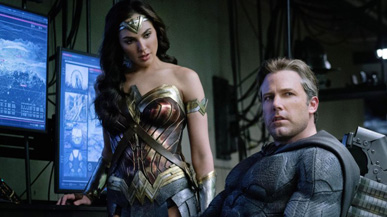Movie Review: Justice League
By Matthew Huntley
November 28, 2017
Compared to the reigning Marvel Comics Universe movies (the latest being “Thor: Ragnarok” and “Spider-Man: Homecoming”), the recent entries from the competing DC canon (“Man of Steel”, “Batman v Superman: Dawn of Justice”) are dark, murky and unwholesome. They possess an underlying cynicism and misanthropy that make it hard to get excited about their stories. It's as if the filmmakers are mad at the world and are using superhero movies as way to destroy it—metaphorically speaking, of course. “Wonder Woman,” with its graceful, compassionate and hopeful heroine, was a bright spot in DC's dour trend, but even she can't make “Justice League” ultimately more fun than gloomy.
Don't get me wrong; “Justice League” is lighter, leaner and more focused than its overwrought and overlong predecessors, but it still lacks that essential spark of excitement all superhero movies should possess—the one that makes us either want to be the heroes or be a part of their world (even the Gotham City in Christopher Nolan's dark and brutal “Batman” trilogy was appealing to a certain extent). The problem, I think, is director Zack Snyder, whose movies are often preoccupied with excessive violence and devastation, so much that the audience simply grows numb watching them. This style can work in some contexts (“Dawn of the Dead,” “300”), but it doesn't seem right for the superhero genre.
As a result, the worlds Snyder creates for Superman and friends are drab and depressing, while the characters themselves never seem to escape a perpetual state of sadness and remorse. And because action and spectacle take priority over character development, the heroes are often one-note and we never feel like we know them, let alone care about them. Plus, the general look of the places and environments they occupy are flat and hazy—they seem to have been filmed with a filter that lessens their overall opacity. Collectively, these qualities make “Justice League” more ineffectual than entertaining.
In the film, which takes place after the events of “Batman v Superman,” the world is fraught with grief and fear now that the Man of Steel is dead (recall he perished battling Lex Luthor's Doomsday creature), and Bruce Wayne/Batman (Ben Affleck) is, as usual, consumed by guilt, holding himself accountable for Superman's demise. But his woes extend beyond mere regret and liability, because Superman's passing has “turned on,” if you will, three energy containers known as the Mother Boxes. For the record, it's still not clear to me what the Mother Boxes actually are or what they do, but let's just say they've existed for thousands of years, yield great power, and have the ability to destroy and remake planets.
This latter attribute is the long short of why the super-villain Steppenwolf (voice of Cirian Hinds) wants to get ahold of them. Known as a “New God,” Steppenwolf lives only to conquer and uses his army of Parademons (winged, bug-like creatures not too far removed from the Wicked Witch of the West's flying monkeys) to attack the various races protecting the boxes, including the Amazons, Atlanteans and humans. Eventually, he acquires what he needs and sets up shop at an abandoned Russian nuclear power plant, where he plans to charge the boxes and reshape the planet.
Continued:
1
2
|
|
|
|




